Back To List

Gary Albright
Conservator in Private Practice
Monique Fischer
Senior Photograph Conservator
Northeast Document Conservation Center
This leaflet introduces the different types of photographs and their distinguishing characteristics and should serve as a basic guide in identifying individual photoprints and negatives.
First, a few useful terms and concepts:
POP (printing-out paper): A photographic paper that forms a visible image directly from the reaction of light on light-sensitive materials. POP prints are warm in tone, tending towards a brown, purple, or reddish color. They are usually made in contact with a negative.
DOP (developing-out paper): A photographic paper that forms a visible image using a chemical developer to reveal the latent image made by exposure to light. DOP prints are cool in color -- blue, neutral, or black -- unless they have been toned or are faded/chemically damaged. They may be either contact-printed or enlarged from a negative.
Coated paper: A support that has a binder layer on its surface consisting of albumen, gelatin, or collodion. This layer holds the light-sensitive photographic salts. A three-layer structure has as its third layer barium sulfate (aka Baryta layer). This layer occurs between the paper and the image layer.
Uncoated paper: A paper support without any binder layer. The image often appears to be within the paper.
When considering a photographic object, there are a few primary features to consider:
- Positive or negative
- Nature of support material
- Texture, surface quality
- Color, tone
- Characteristics of deterioration
Direct Positive Photographs
|
Support
Materials
|
Technique
|
Popular
use dates
|
Image
|
Identifying
Features
|
|
Silver-plated sheet of copper
|
Daguerreotype
|
1839 – c. 1860
|

|
Mirror surface; positive-negative nature; usually housed in a miniature case made of wood covered with leather, paper, cloth or mother of pearl; and/or made of thermoplastic material. Tarnish can form on support.
|
|
Glass
|
Ambrotype
|
1851 – c. 1880
|

|
Milky gray highlights; various black backings, occasionally use ruby glass; usually housed in a miniature case. (See daguerreotype for description.)
|
|
Iron, coated with a black varnish ("Japanned surface") containing raw linseed oil, asphaltum, and pigments
|
Tintype, ferrotype, melainotype
|
1854 –c.1930s
|

|
Milky gray highlights, lack of contrast in image. Rust can form.
|
|
Support Materials
|
Technique
|
Date
|
Image
|
Identifying
Features
|
|
Uncoated Paper
(1-layer structure)
|
Salted paper print
|
1840 – c. 1860
|
 |
POP, matte surface; paper fibers visible; often faded to pale yellow (especially at the edges); sometimes varnished.
|
|
Platinotype
Palladiotype
|
1880 – c. 1930
1916 – c. 1930
|
 |
Gray-black color, matte surface; paper fibers visible; rich, velvety texture; popular with art photographers; usually stable images, little fading or silvering; paper often acidic and discolored; catalyst for cellulose deterioration causing image transfer.
|
|
Cyanotype
(blue-print)
|
c.1880 – c. 1910
|
 |
Brilliant blue color, matte surface; invented in 1842 but not widely used until 1880s; paper fibers visible.
|
|
Coated Paper
(2-layer structure)
|
Albumen print
|
1851 – c. 1900s
|

|
POP, usually semi-glossy surface; red-brown, purple or yellow-brown image; thin paper support, usually on heavy mount; a crackle pattern can often be seen; usually yellowed in highlights; paper fibers visible through albumen coating.
|
|
Carbon print
|
1855-1930
|
 |
Used extensively for reproductions of works of art, also used as tip-ins for book illustration. Subtle image relief; paper fibers visible in highlights; no fading or yellowing; may get large cracks in dark areas; may be any color.
|
|
Woodburytype
(Photoglypty)
|
1866 – c. 1900
|
 |
Same characteristics as carbon prints. Woodburytypes are not photographic, but photomechanical. Mainly used for book illustration and large edition publications; often labeled.
|
|
Coated Paper
(3-layer structure)
|
Collodion print
|
Glossy:
late 1880s–1920s
Matte: 1894 – 1920s
|
 |
POP, glossy surface (sulfur sepia and gold toned, purple color) or matte surface (gold or platinum toned, range of tones possible, usually neutral color), very stable image, rarely faded; easily abraded; usually mounted; paper fibers usually not visible. Glossy collodion prints often exhibit a subtle rainbow effect on their surface when viewed under fluorescent lights.
|
|
Gelatin POP print (silver chloride)
|
c. 1880 – c. 1910
|

|
POP warmer in tonality than a gelatin DOP; brown or purple image hue; usually very glossy; often faded to yellow; paper fibers not visible.
|
|
Gelatin DOP print (silver bromide)
|
c. 1880 – present
|
 |
DOP appears black and white unless image deterioration has occurred, or it may be toned to various warm shades; matte, glossy or textured; often exhibits silvering; may fade; paper fibers not visible.
|
|
Support Materials
|
Technique
|
Date
|
Image
|
Identifying Features
|
|
Paper
|
Calotype, paper negative
|
1841 – c. 1865
|

|
Rare, usually waxed or oiled; paper fibers visible, usually warm image tone.
|
|
Eastman paper negative
|
1885 – c. 1895
|
Not Available
|
Rare, usually in poor condition; small format.
|
|
Glass
|
Collodion wet plate
|
1851 – c. 1880
|
 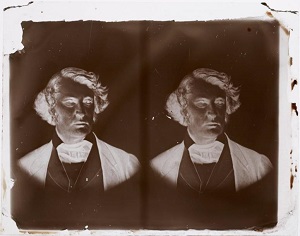
|
Plate coated by hand; uneven coating at the edges; pour lines; rough cut edges of glass; edges often ground; varnished; warm pale image tone; longer density range.
|
|
Gelatin dry plate
|
c. 1880 – c. 1975
|
 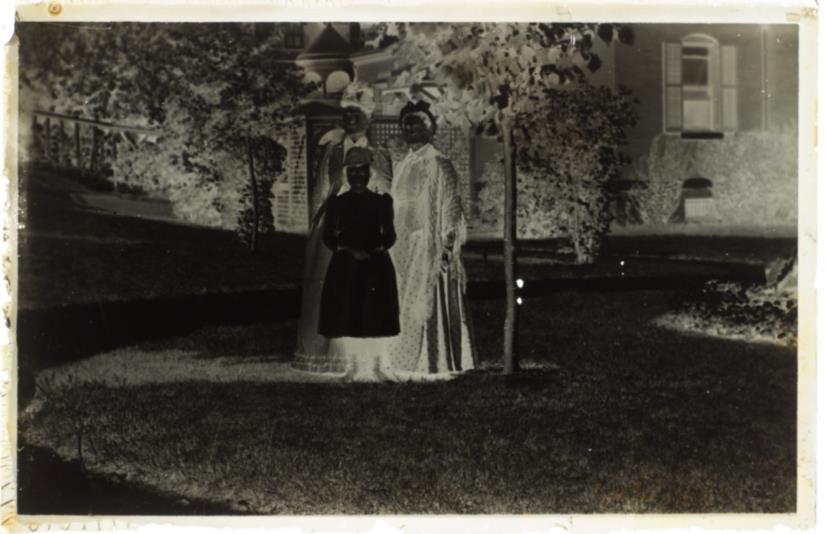 |
Plate is machine coated; even coating at edges; clean cut glass; occasionally varnished; less density range tends to tarnish; usually cool image tone.
|
|
Gelatin
|
Eastman American film
|
1884 – c. 1890
|
Not Available
|
Rare; looks like plastic; brittle, uneven edges; used for Kodak No. 1 (2-1/2" diameter) and Kodak No. 2 (3-1/2" diameter)
|
|
Plastic
|
Cellulose nitrate (sheet film)
|
1913 – 1939
|

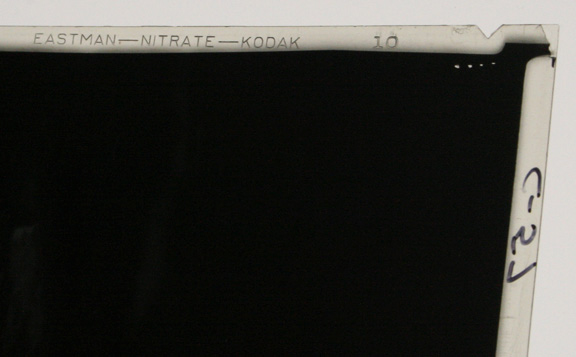 
|
"NITRATE" marked on edge; very flammable; small clipping sinks in trichloroethylene; turns a deep blue in diphenylamine test; degraded products smell very acrid; becomes yellow, brittle, sticky.
|
|
Cellulose acetate, diacetate, triacetate, etc.
|
Black and white: 1925 – present
Color: 1942 to present
|
 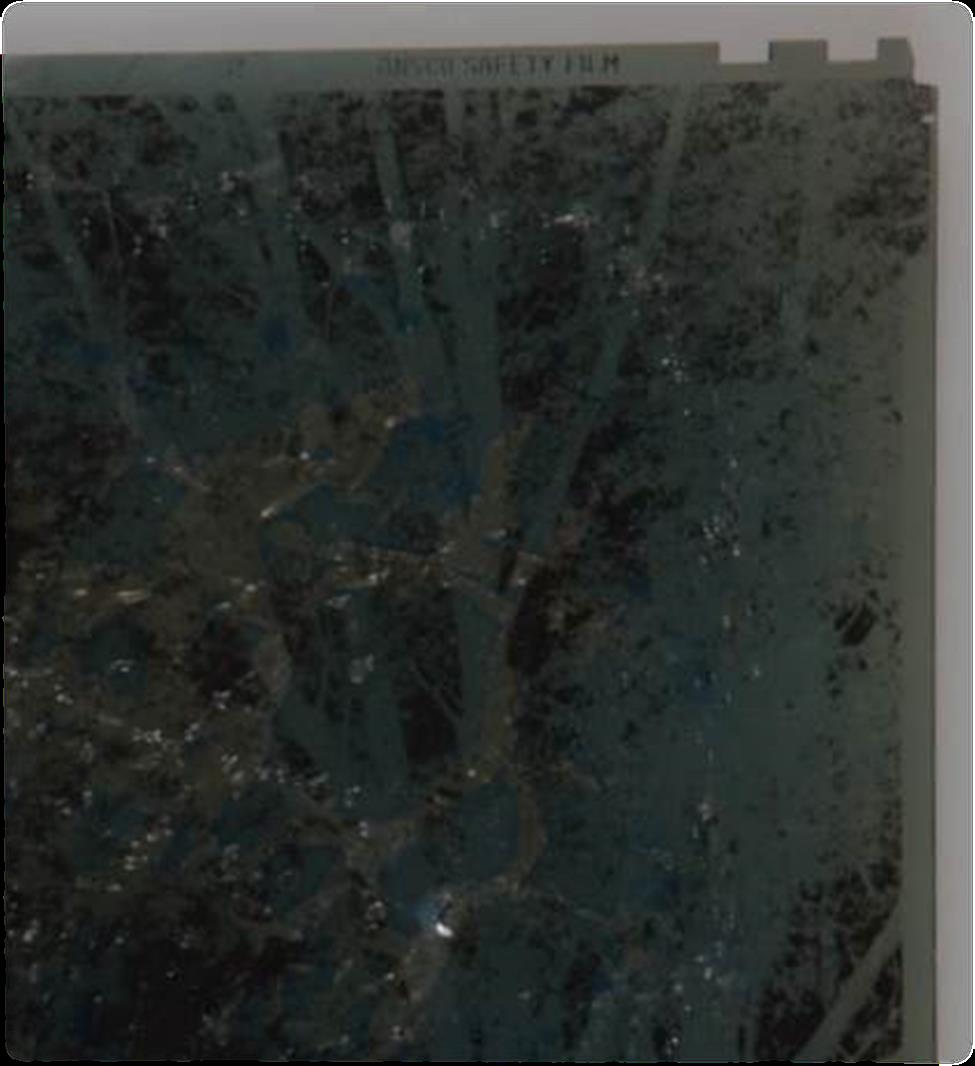
|
"SAFETY" marked on edge; burns with difficulty; clipping floats in trichloroethylene; no blue color in diphenylamine test; degraded products smell of acetic acid (vinegar); channels form between base and emulsion as the negative deteriorates.
|
|
Polyester
|
c. 1965 – present
|
 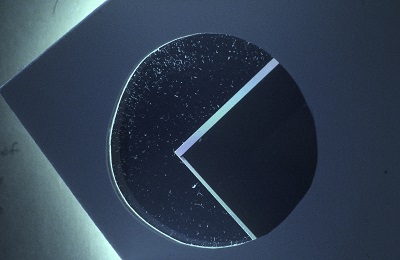
|
When viewed between polarizing filters, the film is identified by interference patterns (rainbow colors); may include edge printing "SAFETY."
|
Resources:
For more information on the care and identification of photographs, please see:
· Reilly, James M. Care and Identification of 19th Century Photographs. Eastman Kodak Company. 1986.
· Image Permanence Institute. “Graphics Atlas.” http://www.graphicsatlas.org/
For more information on the care and identification of film-base materials, please see:
· Guidelines for Care and Identification of Film-base Photographic Materials by Monique C. Fischer and Andrew Robb athttp://cool.conservation-us.org/byauth/fischer/fischer1.html
























